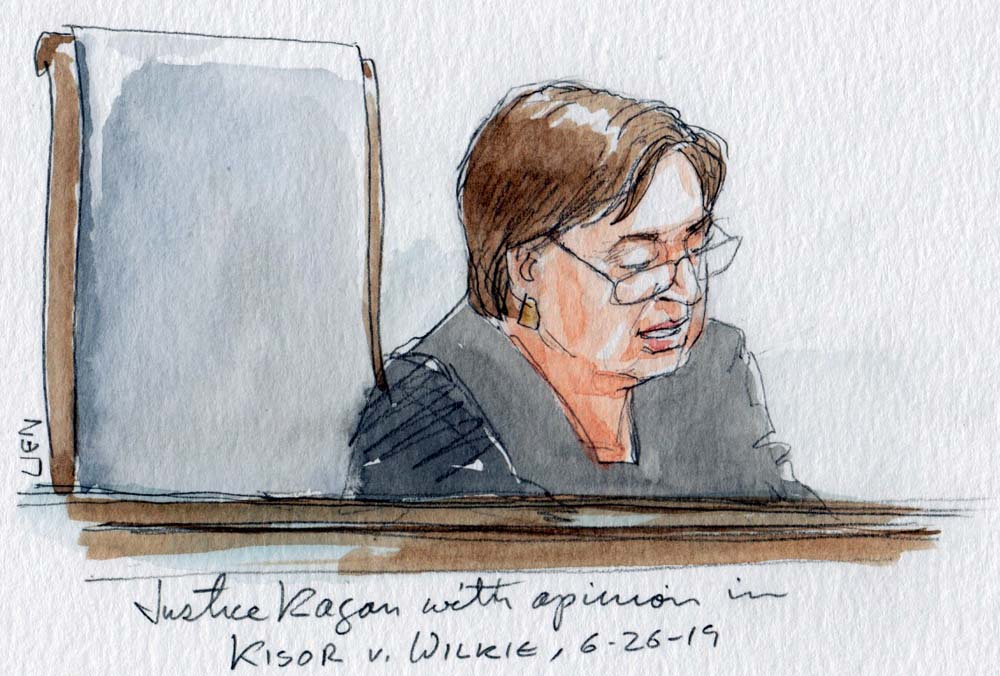Opinion analysis: Justices leave agency deference doctrine in place – with limits (Updated)

on Jun 26, 2019 at 1:20 pm

Editor’s Note: This post, originally published at 11:49 a.m., was expanded at 1:26 p.m.
A divided Supreme Court issued a major opinion on administrative law today. The justices declined to overrule a longstanding line of cases instructing courts to defer to an agency’s interpretation of its own regulation – a doctrine sometimes known as “Auer deference.” But in an opinion by Justice Elena Kagan, the court made clear that the doctrine has limits, and it will not apply in every scenario in which an agency is interpreting its own rules. That was not enough, however, for Justice Neil Gorsuch, who complained that today’s ruling had left the doctrine a “paper tiger” and warned that the court would almost certainly have to address the issue again soon.
The Auer deference doctrine – named after the 1997 case Auer v. Robbins – is also sometimes called Seminole Rock deference, after the 1945 case Bowles v. Seminole Rock & Sand Co. It rests on the idea that agencies have more expertise in the subject covered by a law than courts do and are therefore better suited to interpret both gaps in a federal law and their own regulations. Supporters of the doctrine also believe that the doctrine provides predictability and consistency: Courts are more likely to uphold regulations, they say, because judges only have to determine whether the agency’s interpretation is reasonable, not whether it is the best interpretation. But opposition to the doctrine has grown in recent years, particularly among conservatives and business groups, who believe that it gave federal agencies too much power.
This high-stakes legal issue came to the Supreme Court in the fairly unremarkable case of James Kisor, a Vietnam veteran who applied for benefits for his post-traumatic-stress disorder. The Department of Veterans Affairs agreed with Kisor that he suffers from PTSD but rejected his request for benefits dating back to 1983. When Kisor appealed the VA’s decision to the U.S. Court of Appeals for the Federal Circuit, the court of appeals deferred to the VA’s interpretation of its own regulation and sided with the agency.
Last year Kisor asked the Supreme Court to weigh in, and today the Supreme Court gave him a partial victory. It declined to overrule the Auer doctrine, as he had asked, but it sent his case back to the Federal Circuit for it to take another look.
In her opinion for the court, Kagan stressed that courts should not reflexively defer to an agency’s interpretation of its own regulation. Instead, she explained, deference should be given only if the agency’s regulation is genuinely ambiguous. If it isn’t ambiguous, she continued, the “regulation then must means what it means—and the court must give it effect, as the court would any law.” And she suggested that courts must try hard to resolve any ambiguities that it thinks it sees in a regulation: She acknowledged that “regulations can sometimes make the eyes glaze over,” but emphasized that “hard interpretative conundrums, even relating to complex rules, can often be solved.”
Even when a regulation is genuinely ambiguous, Kagan continued, that is not enough for deference. First, she indicated, the agency’s interpretation must also be reasonable – which, she warned, is “a requirement an agency can fail.” And the interpretation must also reflect the agency’s official position in an area of its expertise. “The upshot of all this,” Kagan concluded, is that, when it applies, “Auer deference gives an agency significant leeway to say what its own rules mean.” “But,” she cautioned, “that phrase ‘when it applies’ is important—because it often doesn’t.”
Kagan added that the principle of stare decisis – the idea that courts should not overrule their prior cases unless there is a good reason to do so – weighs “strongly” against overruling the Auer doctrine. This is particularly true, she observed, because the doctrine isn’t just one case, but “a long line of precedents—each one reaffirming the rest and going back 75 years or more.” And overruling the doctrine now would inject “so much instability into so many areas of the law,” Kagan suggested, because Auer deference is so widespread.
And in any event, Kagan noted, because this is not a constitutional issue, Congress is free to pass a law that would overrule Auer. “Instead,” she observed, “for approaching a century, it has let our deference regime work side-by-side with” federal administrative laws “delegating rulemaking power to agencies. It has done so even after we made clear that our deference decisions reflect a presumption about congressional intent. And it has done so even after Members of this Court began to raise questions about the doctrine.”
Having outlined these limits on Auer deference, the court sent Kisor’s case back to the Federal Circuit for it to take another look at whether the doctrine should apply there. Kagan suggested that the lower court both “jumped the gun in declaring the regulation ambiguous” and “assumed too fast that Auer deference should apply in the event of genuine ambiguity.”
Justice Neil Gorsuch agreed with the decision to send Kisor’s case back to the Federal Circuit, but he – in a ruling joined in full by Justice Clarence Thomas and in part by Justices Samuel Alito and Brett Kavanaugh – was sharply critical of the court’s decision not to overrule Auer, which he described as “more a stay of execution than a pardon.” He made clear that he would “stop this business of making up excuses for judges to abdicate their job of interpreting the law and simply allow the court of appeals to afford Mr. Kisor its best independent judgment of the law’s meaning.”
Gorsuch characterized the Auer doctrine as “really little more than an accident” that “began as an unexplained aside in a decision about emergency price controls at the height of the Second World War.” The doctrine “sat on the shelf, little noticed, for years,” Gorsuch continued, and only recently came into being as “the reflexive rule of deference to regulatory agencies we know today.”
The doctrine, Gorsuch suggested, is deeply flawed. Among other things, it conflicts with the obligations of courts under the Administrative Procedure Act, which “instructs reviewing courts to ‘decide all relevant questions of law’ and ‘set aside agency action’” that does not comply with the law, and it “sits uneasily with the Constitution,” which gives courts the power to interpret the laws.
It is not at all clear that the principle of stare decisis applies to Auer deference, Gorsuch posited, because the court is not “dealing with a precedent that purported to settle the meaning of a single statute or regulation or resolve a particular case.” Instead, Gorsuch reasoned, the Auer doctrine “claims to do much more than that—to prescribe an interpretative method governing every future dispute over the meaning of every regulation.” But even if the principle of stare decisis does apply, Gorsuch continued, there are still good reasons to overrule Auer, because it is flawed and has not provided a workable standard.
Chief Justice John Roberts agreed with the court’s decision not to overrule Auer and its discussion of the limits on Auer deference going forward. However, both Roberts and Justice Brett Kavanaugh (who, like Gorsuch, agreed only with the result in the case) wrote separately to emphasize that, although Kagan and Gorsuch disagree on whether to keep Auer in place, their approaches “should lead in most cases to the same general destination.” If, Kavanaugh wrote, a court tries hard to resolve any ambiguities in a statute, it “will almost always reach a conclusion about the best interpretation of the regulation at issue” and won’t need to defer to the agency’s interpretation. Roberts and Kavanaugh also took pains to make clear that today’s decision is limited to Auer deference and does not affect the doctrine known as Chevron deference, which generally requires courts to defer to an agency’s interpretation of ambiguous statutes enacted by Congress.
This post was originally published at Howe on the Court.



